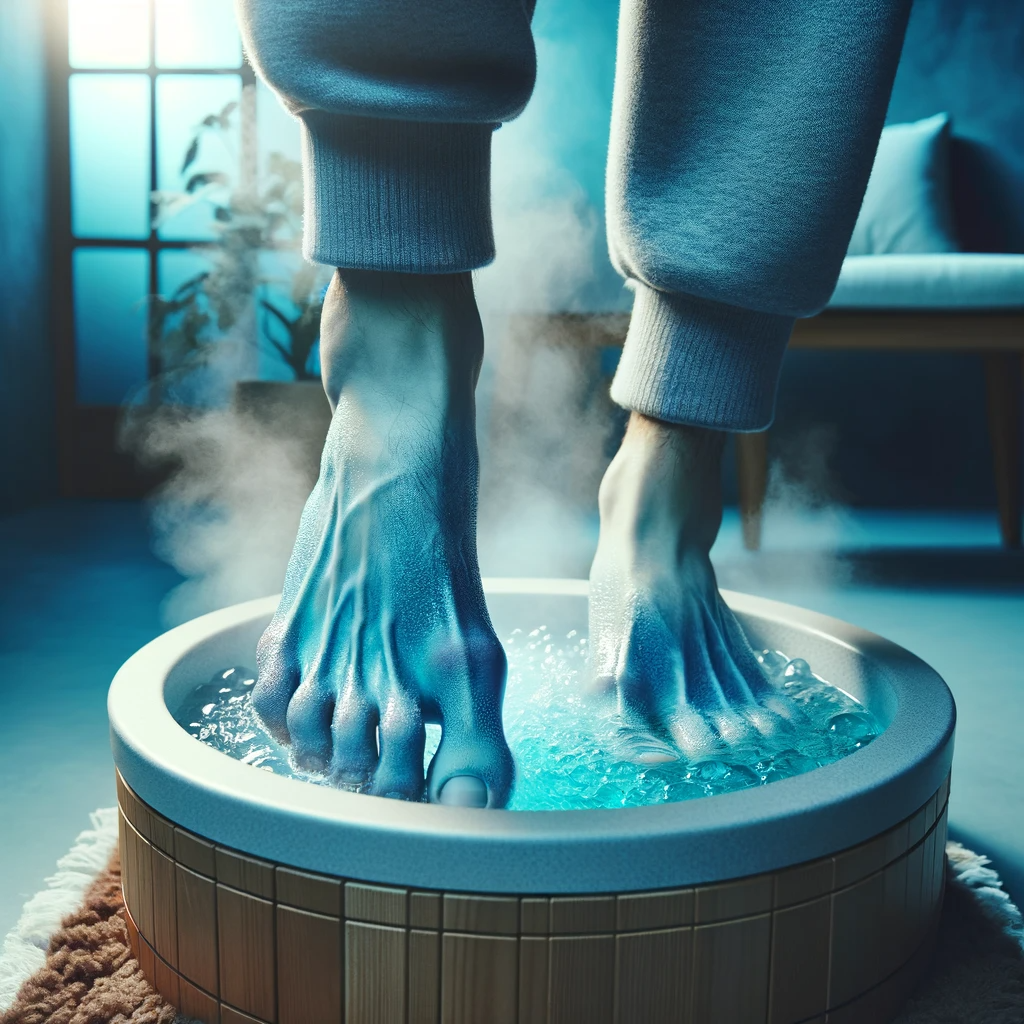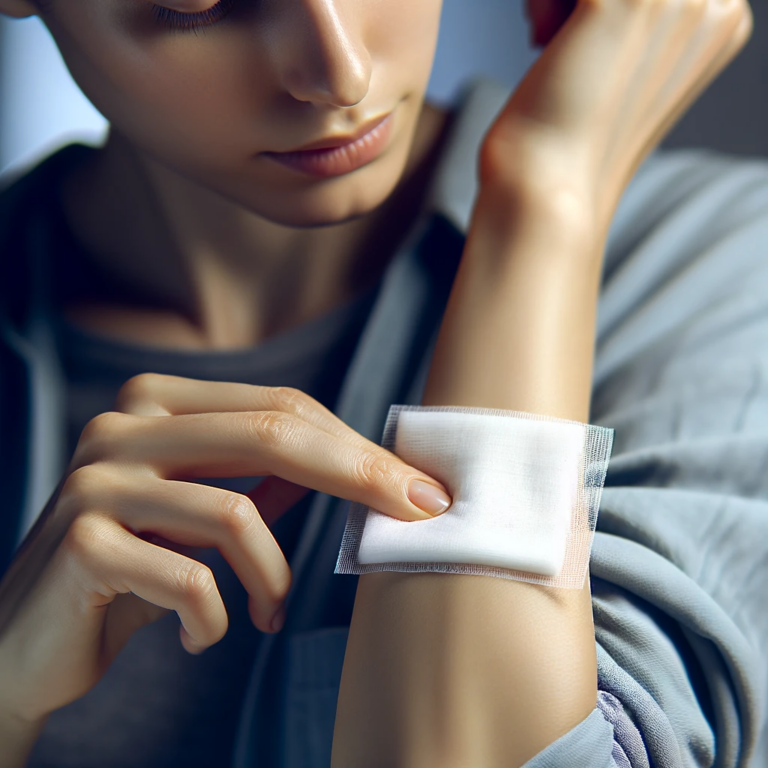ELI5 Summary:
When you dip cold feet into hot water, the sudden temperature jump shocks your skin’s nerve endings and blood vessels. This is because cold constricts your blood vessels, slowing down circulation, and hot water quickly expands them, leading to a rapid blood flow increase. Your nerves, surprised by this rapid change, send out a flurry of signals that can feel like a stinging or tingling sensation. It’s your body’s way of saying, “Hey, that’s a bit too fast for me!” To avoid the sting, warm your feet up slowly instead.
The Mysterious Reaction: Cold Feet Meet Hot Water
From Icy to Fiery: What Happens to Your Feet?
Imagine stepping into a soothing bath after a day out in the cold. Your feet, numb and chilled, expect warmth and comfort, but instead, they’re greeted with a sharp, tingling sting. Why does this happen? When cold feet make contact with hot water, the sudden change in temperature sends a rush of signals to your nervous system, causing blood vessels in your skin to expand rapidly. This process, known as vasodilation, can create an uncomfortable, even painful, sensation as the nerves in your feet react to this swift transition.
The effect is akin to static shock – unexpected and momentarily jarring. Your previously constricted blood vessels, narrowed to preserve body heat in the cold, are now forced to widen. This can lead to a stinging sensation as the warm water starts the thawing process, putting pressure on sensitive nerve endings.
Investigating the Sting: A Closer Look at the Science
Delving deeper into this phenomenon, we uncover that it’s not just a simple matter of hot meets cold. The sting that you feel is a complex ballet involving several physiological reactions. Primarily, there are three things at play: the temperature receptors in the skin, the speed of temperature change, and the body’s natural pain response.
- Your skin has receptors specifically designed to sense temperature changes. These receptors send signals to the brain, indicating cold or heat.
- When your feet go from one extreme temperature to another very quickly, these receptors can fire signals all at once, leading to an overload of information, which the brain may interpret as pain or stinging.
- The sudden vasodilation in response to heat causes increased blood flow. While necessary for warming the feet, it can also result in a sensation akin to mini pins and needles pricking your skin.
By understanding the science behind the sting, we can better grasp why our bodies react in such a way and how we might mitigate the unpleasant sensation. In the following sections, we’ll explore the contributing factors and offer some solutions to help keep your toes toasty without the tang of the sting.
Unraveling the Cause: Factors Leading to the Sting
Temperature Differential: A Key Player in the Drama
The primary culprit behind the sting felt when cold feet meet hot water is the stark temperature differential. On a particularly cold day, your feet can become quite cool, narrowing blood vessels to conserve heat. Plunge those same feet into hot water, and you have an extreme temperature shift; your body’s thermal balance is disrupted, and nerve endings leap into action. The resulting sensation? A stinging alert from your feet that screams for your brain’s attention.
Think of it as a thermal shock — akin to the feeling you get when you walk out into a winter gale after being in a cozy, warm room. Your skin protests, and in the case of your feet, it protests loudly and painfully in the form of stinging.
The Role of Circulation in Thermal Shock
Poor circulation can intensify the discomfort of thermal shock. When feet are cold, circulation is usually slower, due to reduced blood flow. Introducing them to a hot environment prompts a sudden surge of blood to the area, which can overwhelm the vasculature and nerve endings. This rapid change puts the nerves and blood vessels through a rigorous test, often leading to the characteristic sting of heat meeting cold.
-
Reduced Blood Flow: Chilly temperatures cause blood flow to slow, making your feet especially sensitive to changes.
-
Vasodilation: Heat leads to vasodilation, which increases blood flow that can shock systemically cooled tissues and nerves.
-
Sensory Overload: Your nerves may respond to this sudden change by sending ‘pain’ messages as a protective measure.
Skin Sensitivity and Nervous Responses
Skin sensitivity also has a significant role to play in how intensely the sting is felt. Some people may have heightened sensitivity because of an abundance of nerve endings in their feet, or possibly due to skin conditions that affect their protective barriers. Furthermore, nervous responses can vary from one individual to another, meaning that the experience of thermal shock is not universal but can vary greatly based on personal sensitivities.
- Nerve Endings: More nerve endings can mean increased sensitivity to temperature changes.
- Health Conditions: Conditions such as peripheral neuropathy or Raynaud’s phenomenon can affect the way your feet react to heat.
- Individual Differences: Personal tolerance levels to heat and pain can alter the stinging sensation experience.
The combination of temperature differential, circulation factors, and individual skin sensitivity form a trifecta that explains the sting when warming up cold feet. Recognizing these factors helps us develop practical strategies for mitigating discomfort, which we will delve into next.

Soothing Strategies: How to Prevent the Teasing Tingle
Easing Into Warmth: The Gradual Approach
The key to avoiding the sting of cold feet in hot water is a slow and steady increase in temperature. A gradual approach allows your body’s mechanisms to adjust without overloading your nerve endings. Begin by soaking your feet in lukewarm water, incrementally adding warmer water until a comfortable temperature is achieved. This method lets your blood vessels expand more gently, preventing the abrupt sting associated with a rapid plunge.
Imagine you’re easing into a pool; you wouldn’t dive into the deep end without acclimating to the water first. Similarly, give your feet a chance to adjust and the transition from cold to hot will be a lot more pleasant.
- Start with Lukewarm: Initiate your foot soaks with water that’s only slightly warmer than body temperature.
- Gradual Increase: Slowly add hot water to the bath, allowing your feet to acclimate to each temperature change.
- Patience is Key: Take your time with the process to avoid overwhelming your feet’s temperature receptors.
Foot Care Tips to Mitigate the Hot Water Sting
In addition to taking it slow, there are several other foot care strategies that can alleviate the sting and enhance the overall health of your feet:
-
Moisturize Regularly: Apply foot cream to keep the skin’s barrier strong and less prone to sensitivity.
-
Massage Your Feet: Massaging promotes circulation, which can help in reducing the shock of temperature changes.
-
Wear Proper Footwear: Protect your feet from extreme temperatures to prevent the blood vessels from narrowing excessively.
-
Stay Hydrated: Proper hydration can aid in maintaining optimal circulation in your extremities.
By incorporating these protective measures and self-care practices, you’ll not only fend off the infamous sting but also pamper your feet, keeping them healthy and prepared for temperature variances.
Remember, your feet do a lot for you, bearing the brunt of daily activities. It’s essential to give them the care they need, which includes a gentle and nurturing approach when exposing them to new environments, especially those varying in temperature. Follow these strategies, and you’ll soon turn the foot-soaking experience into a moment of pure bliss, free from any stinging encounters.

Myth-Busting: Separating Facts from Wives’ Tales
Debunking Common Misconceptions About Foot Care
Foot care is riddled with myths and old wives’ tales that can be misleading, if not entirely false. It’s time to put some of these misconceptions to rest and focus on what science tells us.
One popular belief is that if your feet are cold, the best solution is to immerse them in the hottest water you can tolerate to ‘shock’ them warm. However, as we’ve outlined, this can cause the poignant stinging we’re looking to avoid. Extreme temperatures are more harmful than beneficial, and the notion that they can ‘kickstart’ circulation is a dangerous oversimplification.
Another myth is that the stinging sensation is an indicator of underlying health issues. While it’s true that certain conditions can exacerbate sensitivity to temperature changes, the sting from plunging cold feet into hot water is a normal physiological response for most people. It’s important to distinguish between common reactions and symptoms that consistently cause discomfort or pain.
Real Advice Versus Fiction: What Actually Works
Real advice based on proper foot care should always be grounded in anatomical and physiological knowledge. This includes understanding that gradual temperature adjustments and good foot hygiene are the cornerstones of preventing discomfort. Practices such as wearing appropriate socks and shoes, keeping your feet dry and warm, and avoiding abrupt temperature changes are not only effective but also recommended by healthcare professionals.
- Gradual Warming: Always warm cold feet gradually to prevent stinging sensations.
- Dry Socks and Shoes: Keep your feet dry to maintain healthy circulation and skin integrity.
- Avoid Direct Heat: Don’t use heating pads or hot water bottles directly on cold feet.
By shunning the myths and focusing on factual, effective care tips, we not only ensure the well-being of our feet but also enhance our overall comfort. Remember to treat your feet with the same consideration you’d afford any other part of your body. Educate yourself on the dos and don’ts, and enjoy the pleasure of happy, healthy feet.
Firsthand Experiences: Stories From the Foot Soaking Community
Anecdotes of Foot Care Routines and Revelations
Personal stories often offer a wealth of knowledge, bringing to life the trials and errors that lead to the discovery of effective remedies. The foot soaking community, a passionate group dedicated to the art and science of foot care, shares a bevy of insights that underscore the importance of personalized foot care routines.
One individual recounted the time they switched from immediate hot soaks to gradual warm water immersions, resulting in not only an end to stinging sensations but also a more relaxing experience. They learned that patience could be the key to both better foot health and ultimate relaxation.
Another community member found their solution in essential oils. By adding a few drops to their foot bath, they not only enhanced the sensory pleasure of the soak but also provided necessary nutrients and moisture that their skin craved. This simple addition made a world of difference in preventing discomfort.
The Power of Community Knowledge in Skin and Foot Health
Perhaps the most striking revelation is the collective wisdom found in shared experiences. Community forums and discussions often reveal patterns and consistent solutions that have worked for many—highlighting methods that may not be widely known or recognized in mainstream sources.
-
Sharing Success: Individuals often share their most successful strategies for avoiding the sting when introducing cold feet to hot water.
-
Collective Troubleshooting: The community acts as a sounding board, helping to troubleshoot when someone’s method isn’t as effective as hoped.
-
Pooling Resources: From product recommendations to homemade remedy formulas, pooling resources ensures a wide array of options.
Listening to the stories of others and learning from their experiences is invaluable. Not only do these anecdotes provide practical advice, but they also offer a sense of camaraderie and support within the community. Whether it’s a tried-and-true soaking method or a novel DIY solution, the shared knowledge of the foot soaking community is a treasure trove for anyone seeking healthy, happy feet without the sting.

Your Action Plan: Say Goodbye to Cold Feet Distress
Simple Yet Effective Foot Soaking Techniques
Armed with knowledge and community-tested advice, you’re well on your way to banishing the sting and embracing the warmth. Let’s craft an action plan that incorporates simple, yet effective, foot soaking techniques. Start with preparing a foot bath with water at room temperature, and then gradually add warm water until you reach a comfortable temperature. This incremental approach allows your feet to acclimate without the sting.
Furthermore, consider adding Epsom salts, known for their muscle-relaxing properties, or essential oils for additional therapeutic benefits. The key is to mix soothing practices with the right temperature to pamper your feet effectively.
- Prepare with Care: Begin your foot bath with neutral or slightly warm water.
- Incremental Warmth: Add warmth gradually, testing the water regularly to ensure comfort.
- Additives for Relaxation: Enhance your soak with Epsom salts or a few drops of your preferred essential oils.
Implementing a Foot Care Routine That Suits Your Lifestyle
A foot care routine should be customized to fit seamlessly into your lifestyle. Whether you’re constantly on-the-go or you have more time to pamper yourself, creating a routine that’s both manageable and enjoyable is key. Set aside time each week for a soak, and commit to daily moisturizing to keep your feet at their best. Remember to also include foot exercises or massages to boost circulation.
Adjust the frequency and methods of care according to the seasons or your activity level—your feet’s needs will differ depending on the environment and the stress they’re under. With commitment and regularity, this customized routine will keep the sting at bay and ensure that your feet remain a source of comfort, not pain.
- Daily Practices: Moisturize daily and consider quick, warm foot rinses each evening.
- Weekly Rituals: Dedicate time for a thorough soaking session once a week.
- Seasonal Adjustments: Tailor your foot care regime to the seasonal demands on your feet.
By establishing and adhering to a comprehensive action plan, not only will you say farewell to the adversity of cold feet, but you’ll also walk a path of healthier habits and greater overall well-being. Embrace these steps, fine-tune your routine, and watch as your feet carry you comfortably through each day, free from the sting of hot water surprises.
Enhancing Comfort: The Final Touches to Warm Feet Without the Sting
Choosing the Right Footwear for Cold Climates
Your journey to avoiding the sting doesn’t end with foot soaks. It extends to your everyday life choices, specifically the footwear you choose to combat cold climates. Wearing proper, insulated footwear is your first line of defense against cold feet. Opt for shoes with moisture-wicking material to keep feet dry and adequate insulation to maintain warmth. Consider the sock and shoe combination as a dynamic duo fighting against the cold, set to protect you long before you think about stepping into hot water.
-
Moisture-Wicking Materials: Choose socks that draw moisture away from the skin to prevent dampness.
-
Good Insulation: Insulated footwear keeps the cold out and the warmth in, ensuring your feet stay comfortable.
-
Fit and Comfort: Ensure your shoes fit well to avoid restricting circulation which can lead to colder feet.
Tracking Your Progress and Adjusting as Needed
As with any good routine, tracking your progress helps identify what’s working and what’s not. Keep a simple journal or notes to record the condition of your feet, the methods you’re using, and how effective they are. Over time, you’ll notice patterns and can adjust your approach to foot care as necessary. The goal is to develop a customized plan that caters precisely to your needs and evolves with you.
By noting the changes in how your feet respond to different temperatures or care techniques, you can refine your strategies to ensure the sting of hot water becomes a distant memory. Your feet will thank you for the attentive care and consideration you’ve given them, rewarding you with warmth and comfort free from discomfort.
- Journal Your Journey: Record the details of your foot care routine and the reactions you observe.
- Notice the Nuances: Pay attention to how your feet respond to changes in your routine.
- Be Adaptable: Stay flexible and willing to change your methods for the best results.
The lessons learned through attentive care are invaluable. As you move through your foot care journey, feel empowered knowing that you’re equipped with the knowledge and strategies needed to protect your feet from the sting and provide them with the nurturing environment they deserve. With the right practices, the right gear, and the right attention to detail, you’ll enjoy every step of your journey — sting-free.




